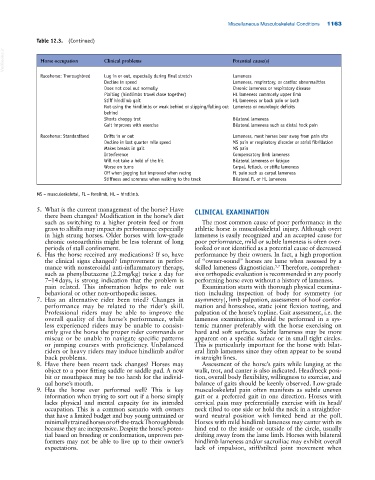Page 1197 - Adams and Stashak's Lameness in Horses, 7th Edition
P. 1197
Miscellaneous Musculoskeletal Conditions 1163
Table 12.3. (Continued)
VetBooks.ir Horse occupation Clinical problems Potential cause(s)
Racehorse: Thoroughbred Lug in or out, especially during final stretch Lameness
Decline in speed Lameness, respiratory, or cardiac abnormalities
Does not cool out normally Chronic lameness or respiratory disease
Plaiting (hindlimbs travel close together) HL lameness commonly upper limb
Stiff hindlimb gait HL lameness or back pain or both
Not using the hindlimbs or weak behind or slipping/falling out Lameness or neurologic deficits
behind
Shorts choppy trot Bilateral lameness
Gait improves with exercise Bilateral lameness such as distal hock pain
Racehorse: Standardbred Drifts in or out Lameness, most horses bear away from pain site
Decline in last quarter mile speed MS pain or respiratory disorder or atrial fibrillation
Makes breaks in gait MS pain
Interference Compensatory limb lameness
Will not take a hold of the bit Bilateral lameness or fatigue
Worse on turns Carpal, fetlock, or stifle lameness
Off when jogging but improved when racing FL pain such as carpal lameness
Stiffness and soreness when walking to the track Bilateral FL or HL lameness
MS = musculoskeletal, FL = forelimb, HL = hindlimb.
5. What is the current management of the horse? Have CLINICAL EXAMINATION
there been changes? Modification in the horse’s diet
such as switching to a higher protein feed or from The most common cause of poor performance in the
grass to alfalfa may impact its performance especially athletic horse is musculoskeletal injury. Although overt
in high strung horses. Older horses with low‐grade lameness is easily recognized and an accepted cause for
chronic osteoarthritis might be less tolerant of long poor performance, mild or subtle lameness is often over
periods of stall confinement. looked or not identified as a potential cause of decreased
6. Has the horse received any medications? If so, have performance by their owners. In fact, a high proportion
the clinical signs changed? Improvement in perfor of “owner‐sound” horses are lame when assessed by a
mance with nonsteroidal anti‐inflammatory therapy, skilled lameness diagnostician. Therefore, comprehen
5,7
such as phenylbutazone (2.2 mg/kg) twice a day for sive orthopedic evaluation is recommended in any poorly
7–14 days, is strong indication that the problem is performing horse even without a history of lameness.
pain related. This information helps to rule out Examination starts with thorough physical examina
behavioral or other non‐orthopedic issues. tion including inspection of body for symmetry (or
7. Has an alternative rider been tried? Changes in asymmetry), limb palpation, assessment of hoof confor
performance may be related to the rider’s skill. mation and horseshoe, static joint flexion testing, and
Professional riders may be able to improve the palpation of the horse’s topline. Gait assessment, i.e. the
overall quality of the horse’s performance, while lameness examination, should be performed in a sys
less experienced riders may be unable to consist temic manner preferably with the horse exercising on
ently give the horse the proper rider commands or hard and soft surfaces. Subtle lameness may be more
miscue or be unable to navigate specific patterns apparent on a specific surface or in small tight circles.
or jumping courses with proficiency. Unbalanced This is particularly important for the horse with bilat
riders or heavy riders may induce hindlimb and/or eral limb lameness since they often appear to be sound
back problems. in straight lines.
8. Have there been recent tack changes? Horses may Assessment of the horse’s gaits while lunging at the
object to a poor fitting saddle or saddle pad. A new walk, trot, and canter is also indicated. Head/neck posi
bit or mouthpiece may be too harsh for the individ tion, overall body flexibility, willingness to exercise, and
ual horse’s mouth. balance of gaits should be keenly observed. Low‐grade
9. Has the horse ever performed well? This is key musculoskeletal pain often manifests as subtle uneven
information when trying to sort out if a horse simply gait or a preferred gait in one direction. Horses with
lacks physical and mental capacity for its intended cervical pain may preferentially exercise with its head/
occupation. This is a common scenario with owners neck tilted to one side or hold the neck in a straightfor
that have a limited budget and buy young untrained or ward neutral position with limited bend at the poll.
minimally trained horses or off‐the‐track Thoroughbreds Horses with mild hindlimb lameness may canter with its
because they are inexpensive. Despite the horse’s poten hind end to the inside or outside of the circle, usually
tial based on breeding or conformation, unproven per drifting away from the lame limb. Horses with bilateral
formers may not be able to live up to their owner’s hindlimb lameness and/or sacroiliac may exhibit overall
expectations. lack of impulsion, stiff/stilted joint movement when

